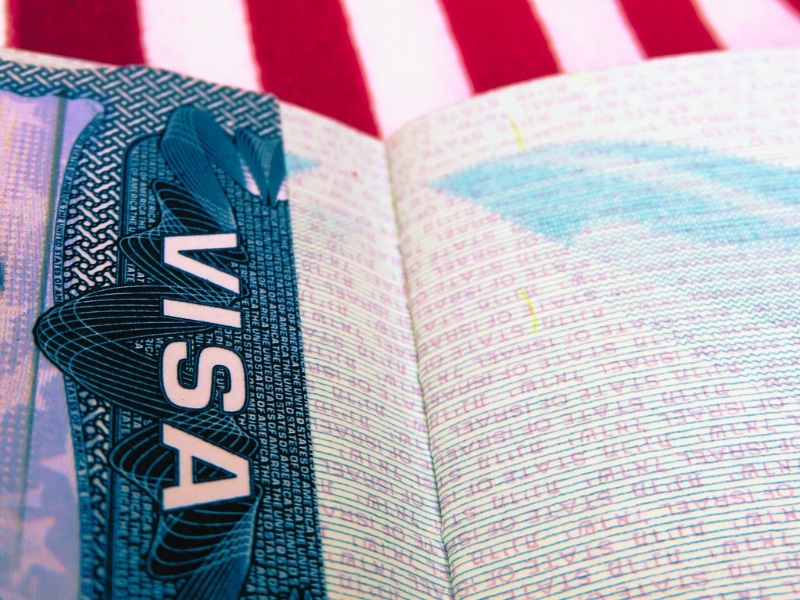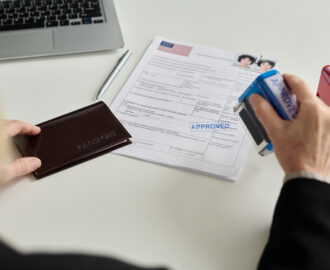If you want to enter the U.S. for a certain period of time, you may seek either the B-1 visa process if you’re entering for business purposes or the B-2 visa if you’re entering as a tourist or for leisure. Knowing the differences between these visas and their processes can help you determine which visa to obtain and go through the application process.

This guide will explore the differences between these visas and how the application processes work for both.
What Is the Difference Between a B-1 and B-2 Visa?
When considering entering the U.S., you might ask, “What is a B-1 or B-2 visa?” First, it’s important to know about the four types of immigrant statuses and what they mean. These statuses include U.S. citizens, lawful permanent residents (LPRs), non-immigrants, and undocumented immigrants.
The first two categories, citizens and residents, can live and work in the U.S. Non-immigrants can enter the country temporarily, but they won’t be able to live in the U.S. and will be unable to work without a business visa. Undocumented immigrants are unable to legally visit, live, or work in the U.S. until they obtain a non-immigrant or immigrant visa.
B-1 and B-2 visas are similar in that they’re non-immigrant visas that allow foreign individuals to enter the U.S. for a limited period. These visas are ideal if you don’t intend to become a lawful permanent resident or U.S. citizen.
However, they differ in the specific reasons for obtaining them. B-1 visas are business visas that allow individuals to enter the country to conduct business. Meanwhile, B-2 visas are for people entering the country as tourists or for leisure.
Although these visas have different purposes behind them, the visa application process of obtaining both is relatively the same. When applying for these visas, you will need to undergo an interview at an American embassy or consulate in your country of origin. The purpose of this interview is to confirm the reason you intend to enter the country, while giving you the opportunity to prove your intentions.
If you are able to acquire either a B-1 or B-2 visa, you may enter the country repeatedly with a visa that remains valid for multiple years, but you will only be able to remain in the country for several months in most cases.
Ultimately, you’ll need to determine whether to obtain a B-1 or B-2 visa based on the purpose of your temporary visit to the U.S.
Eligibility for a B-1 and B-2 Visa in the United States
If you’re considering entering the U.S. on a B-1 or B-2 visa, you must meet each visa’s eligibility criteria, which you will prove in an interview at your country’s U.S. embassy or consulate.
Eligibility for the B-1 Visa
When applying for the B-1 visa, you must be able to show that you intend to enter the U.S. for a valid reason pertaining to business. For example, a company may hire you temporarily for your expertise in a particular field that isn’t easy to access in the U.S. You may also want to enter the country to attend an important conference or trade show in your field that can help you progress in your career.
You may also be able to enter the country as a lecturer, researcher, or trainee.
Eligibility for a B-2 Visa
If you want to obtain a B-2 visa, you will need to show that you intend to visit the U.S. for reasons regarding leisure or tourism. Examples of these instances might include visiting the country for sightseeing purposes or visiting relatives.
In addition to showing that you intend to visit the country for business, leisure, or tourism, you may also need to prove that you can take care of yourself financially while in the U.S. The latter element will be particularly crucial seeing as a B-1 or B-2 visa doesn’t permit you to gain employment in the U.S. during your stay.
Restrictions for B-1 and B-2 Visitor Visa Holders
Before applying for a B-1 or B-2 visa, keep in mind that there are restrictions in place for these visas.
As mentioned, you will be unable to gain employment in the U.S. on a B-1 or B-2 visa, which is why you must be able to prove that you’ll be able to support yourself financially while in the country during your interview.
Additionally, you will normally be unable to change to another visa while visiting the U.S. However, if you want to find out how to change from an H-1B visa to a tourist visa or try to process another visa change, you may be able to under certain circumstances. To determine your options, it’s best to consult with an immigration attorney to discuss the application and a potential visa change.
How to Apply for a Visitor Visa
With a better idea of what to expect with a B-1 or B-2 visa, you can move on to exploring how to get a tourist visa or a business visa.
The following are the steps you’ll need to take to apply for a B-1 or B-2 visitor visa:
1. File the Necessary Form
The first step to apply for a B-1 or B-2 visa is to file Form DS-160, the Online Non-Immigrant Application. You can file this form online, and you can save and print a copy to bring to your interview at the embassy or consulate. You will also need to pay an application fee to begin the process.
2. Upload a Photo
You will also need to upload a digital photo of you to include with your application.
3. Schedule and Attend Your Interview
The next step will involve scheduling your interview with your country’s U.S. embassy or consulate. During this interview, an officer will ask you various questions about you and the reason you want to enter the U.S. You will present a physical copy of Form DS-160 and other supporting documentation.
Also, officers often take digital fingerprints of applicants during the interview process. After the interview, officers may ask for certain additional documentation and details that can help them decide whether to approve or deny your application.
Documentation You’ll Need When Applying
There are several pieces of documentation that you’ll need to bring with you to your interview and provide to the U.S. government when applying for a B-1 or B-2 visa. These documents include:
- A valid passport that will remain valid for six months following the return date
- Proof of your ability to financially support yourself, including funds that will cover all aspects of your visit from travel to living expenses
- A digital photograph of the applicant that’s in color, properly sized, and meets other government requirements
- Proof of ties that connect the applicant to the U.S., including property, work, and relatives
- If you have visited the U.S. in the past more than five times, you will also need to provide documentation of the previous five visits
Can You Extend and Renew a B-1 or B-2 Visa?
If your visa is about to run out, you may want to request an extension or renewal. It’s possible to do so by taking the right steps.
The first step you must take to extend your B-1 or B-2 visa is to complete Form I-539, Application to Extend/Change Nonimmigrant Status. To avoid potential issues when in need of an extension, submit your request form at least 45 days prior to the expiration of your visa.
If you want to renew your visa, you must repeat the original visa application process. This will entail completing and filing all necessary documents and attending another interview to discuss the reason for the renewal.
When to Apply for an ESTA Instead of a B-1 or B-2 Visa
Individuals who are citizens of one of the countries taking part in the Visa Waiver Program may be able to apply for an Electronic System for Travel Authorization (ESTA) instead of a B-1 or B-2 visa.
What makes the ESTA potentially more ideal than a B-1 or B-2 visa is the ability to apply for it online for added convenience. People entering through ESTA may be able to enter the country for business, tourism, or leisure, but remember that your stay in the U.S. on an ESTA will be shorter than a stay on a B-1 or B-2 visa. Specifically, you will be able to stay in the country for up to 90 days on an ESTA. Meanwhile, you’ll be able to stay in the U.S. for six months on a B-1 or B-2 visa, with the ability to extend this visit to a year.
Get Help When Needed
If you want to apply for a B-1 or B-2 visa, you might be unsure about how to approach the application process, or you might have certain concerns. If you need assistance, you may benefit from reaching out to a business immigration lawyer.
An experienced lawyer can answer any questions you have and help you determine what approach to take to your case, including whether you may benefit from a B-1, B-2, or another type of visa based on your unique circumstances. In addition, the right legal counsel may help reverse a denial of a B-1 or B-2 visa if the government rejects your application. An attorney may also help with many other types of immigration cases, including seeking naturalization or helping navigate the legal process when facing deportation.
If you’re considering working with an immigration attorney when applying for a B-1 or B-2 visa, you can find the right representation by knowing what to ask an immigration lawyer.
The following are some key questions to ask when interviewing an immigration lawyer:
How Much Experience Do You Have With B-1 and B-2 Visa Cases?
When you have concerns regarding B-1 or B-2 visas, try to find an immigration lawyer familiar with these visa types and what their application process entails. An immigration with experience in this area will be able to answer questions about what to expect and address any concerns you may have.
Who Will Handle My Case?
If you need help when applying for or re-applying for a B-1 or B-2 visa, you should find out who will handle your case. While the attorney you consult with might be the lawyer who handles your case in a small or solo firm, larger firms will often have staff handle paperwork and communicate with clients. The attorney you speak with should let you know who will specifically be helping you with your case.
What Kinds of Successes Do You Have?
Ask the attorney about experience and successes. He or she may be able to detail similar cases and talk about the kinds of results achieved with clients in similar situations. You should also be able to find testimonials and reviews from past clients online, which can give you a better idea of what kinds of results you can expect with the attorney.
By asking these and other questions in a consultation, you can determine who is the right attorney to represent you. Even if the attorney can’t provide representation and further assistance, he or she may be able to guide you in the right direction to help you apply for a B-1, B-2, or another visa type, depending on what you want to achieve.
Decide If the B-2 or B-1 Visa Process Is Right for You
If you plan on being in the U.S. for a short amount of time for business or leisure, you may consider the B-2 or B-1 visa process. A B-1 visa is ideal if you want to enter the country for business purposes, while a B-2 visa is suitable for individuals visiting the country as tourists or vacationers. Choosing the right visa and preparing your application properly will help increase your chances of successfully entering the U.S.




